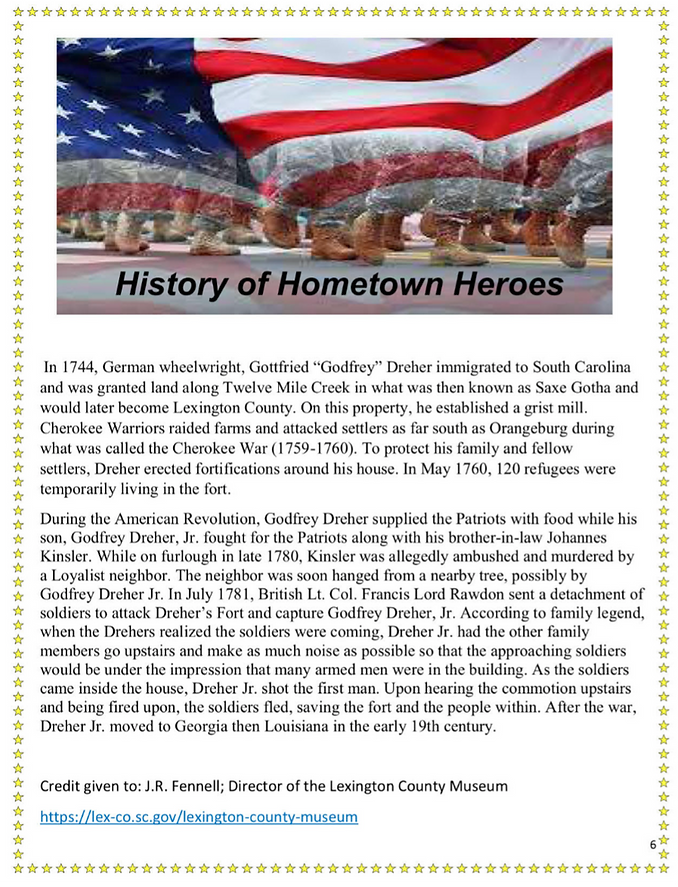OUR LEXINGTON, SC SONS OF THE AMERICAN REVOLUTION CHAPTER DRAWS MEMBERS FROM LEXINGTON, WEST COLUMBIA, IRMO, COLUMBIA, AND THE SURROUNDING MIDLANDS.

sarlexingtonsc.org
Godfrey Dreher Chapter
Lexington, South Carolina

MAIN
MENU
TIMELY DOCUMENTS
OUR LEXINGTON, SC SONS OF THE AMERICAN REVOLUTION CHAPTER DRAWS MEMBERS FROM LEXINGTON, WEST COLUMBIA, IRMO, COLUMBIA, AND THE SURROUNDING MIDLANDS.
SOCIETIES'
LINKS
SAR
Magazine
SCSSAR
SCSSAR
Palmetto
Patriot
SAR 250
SC 250
HISTORICAL
RESEARCH
LINKS
The Godfrey Dreher Chronicles
While our chapter was named for Godfrey Dreher, Sr. (1720-1798), his son Godfrey Dreher, Jr. (1760-1815) could certainly have qualified as our namesake. Indeed, both Patriots made contributions to the founding of our country.
After the American Revolution, the grandson of Godfrey Dreher, Sr, Godfrey Dreher III (1789-1875) made notable contributions to the life of the Lexington area though his Lutheran ministry that introduced services in English.
Below is information we have discovered that discusses each and their contributions. This information will be under perpetuual maintenance and updated as more information is discovered.
Nelson McLeod, our chapter president, has been a great resource in discovering much of this information.
Edited by Jim Herritage, Technical Vice President, Godfrey Dreher Chapter, SCSSAR
August 2025
Godfrey Dreher, Sr. and Jr.


Article from 2009 appeared in the Palmetto Patriot
Godfrey Dreher, Sr. - Our chapter's namesake



Above rendering courtesy of the Lexington County Museum




Godfrey Dreher, Jr.


Image created by ChatGPT 5.0, Prompt by Jim Herritage, 08/28/2025


The above article reports that South Carolina Senator Butler praised the heroic actions referenced above before the U.S. Congress, presumably back in 1856. That statement has not yet been documented. Jim Herritage

Godfrey Dreher, III
Birth: December 4, 1789 — Lexington County, SC
Death: July 28, 1875 — Lexington County, SC
Godfrey Dreher III (December 4, 1789 – July 28, 1875) was a formative Lutheran minister in what is now Lexington County, South Carolina. Born at the close of the eighteenth century to the prominent Dreher family of the Dutch Fork, he matured into a bridge between the region’s German-speaking colonial church and a rapidly Anglicizing South Carolina in the new republic. His lifespan—spanning from the first generation after the Revolution into Reconstruction—made him a steady pastoral presence in a community undergoing profound linguistic, cultural, and political change.
By local recollection and later church histories, Dreher helped organize and then led St. Michael’s Evangelical Lutheran Church in 1814, a congregation founded explicitly to offer worship in English. The initiative drew members from German-heritage congregations—Zion, Bethel, High Hill, and Twelve-Mile Creek—who had been meeting in a schoolhouse since 1812. Land for the new church was provided by the minister’s father, John Dreher. This “Old Blue Church,” as tradition calls it, became a focal point for English-language Lutheranism west of the Congaree.
Dreher’s ministry, however, radiated well beyond a single pulpit. He supplied and assisted neighboring congregations across the Dutch Fork, part of an era when a handful of pastors rode circuits to knit scattered settlements into a functioning ecclesial network. Bethel Lutheran records remember him arriving as an assistant pastor by 1817, while other congregational histories note his steady service to churches that had not yet bound themselves to a synod. An 1827 notice places him preaching at Bethlehem (Bookman’s) on the Broad River, baptizing and catechizing in the midst of seasonal itineration. Together these snapshots convey a portrait of an energetic churchman whose influence was pastoral, practical, and quietly institutional. dutchforkchapter.orgst-jacobs.orggenealogytrails.com
Dreher’s roots tied him to one of the county’s oldest Lutheran communities. Zion Lutheran Church—whose earliest site stood near Dreher’s Fort on Twelve-Mile Creek—traced its origins to the 1740s, when German settlers fortified homesteads against the dangers of the backcountry. In the nineteenth century, ministers like Dreher inherited Zion’s legacy while adapting worship and governance to American patterns and English speech. The result was a Lutheranism both recognizably confessional and regionally distinctive, shaped by migration, frontier realities, and the religious democratization of the early republic.
Late in life, Dreher remained active in the orbit of family and parish. Contemporary memorials and compiled genealogies agree that he died on July 28, 1875, aged eighty-five, and was buried at St. Michael’s Lutheran Church Cemetery. An obituary summarized by later compilers situates his death at Pine Ridge, after which clergy and laity gathered for services reflecting the affection he had earned over decades. Though many of his sermons and letters have not survived, the congregations he stabilized—and the transition he shepherded from German to English Lutheranism—are enduring monuments to his vocation.
(The article was created by ChatGPT 5.0, prompted by Jim Herritage.)
"The Old Blue Church" Since 1814
At a school house in the Pleasant Spring Community of the Dutch Fork in South Carolina, members from Bethel, High Hill and Zion, Twelve Mile Creek gathered to worship starting in 1812. By 1813 they understood their need for an English-speaking congregation and founded Saint Michael’s Lutheran Congregation. Within a year, a Church was constructed and they affiliated with the North Carolina Synod, on October 18, 1814.

















